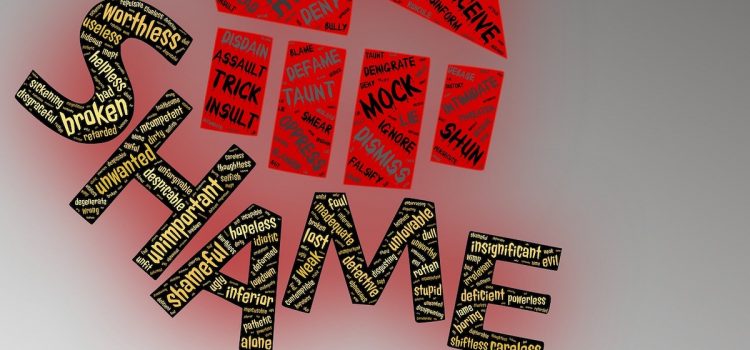

This article gives you a glimpse of what you can learn with Shortform. Shortform has the world’s best guides to 1000+ nonfiction books, plus other resources to help you accelerate your learning.
Want to learn faster and get smarter? Sign up for a free trial here .
Do you feel like a terrible person because of a mistake you made? How can you deal with shame in a healthy way?
A common reaction people have when they’ve done something wrong is to feel shame. It’s a completely normal emotion to feel in these types of situations, but it can have detrimental effects on your mental health. Luckily, there are ways to overcome shame.
Continue reading to learn how to deal with shame and accept your mistakes.
What Is Shame?
Daring Greatly by Brené Brown describes shame as the fear of not being worthy of connection and belonging. It is the fear that you are not enough and will be rejected for your weaknesses. It overtakes the prefrontal cortex and initiates your fight or flight response. Instead of being able to think critically or analyze the legitimacy of a threat, you’re thrust into survival mode.
Once the shame cycle begins, you really only have three options: fight, freeze, or run. In terms of human behavior, this might look like aggression, numbing, or people pleasing. Being in this type of survival mode prevents you from connecting meaningfully with yourself and others, which impedes your ability to live wholeheartedly.
It’s common to confuse guilt, shame, embarrassment, and humiliation. It’s important that you understand the difference, because each sends a different message, and you want to focus on internalizing messages that help you move away from shame, rather than towards it. What is the difference?
- Shame: I did a terrible thing and I am a terrible person.
- Guilt: I did a terrible thing, and I feel responsible, but I’m not a terrible person.
- Humiliation: I am being treated terribly for doing something, but I do not deserve it.
- Embarrassment: I did something that made me feel terrible, but is not actually terrible, and I know I’m not alone.
Shame in particular is toxic, and prevents wholeheartedness, because it conflates your behavior with who you are, corroding your belief in your ability to grow. It also impedes action, because it makes you believe that if you do something bad, you are inherently bad, which prevents you from feeling like it’s possible to change. Therefore, shame is inherently destructive.
Categories of Shame
Brown’s research identified 12 categories of shame that fall under three core themes.
Body Image and Health
- Mental and physical health: Fear of not having a fit enough body, not being strong enough, not being smart enough, and so on.
- Addiction: Fear of never feeling happy enough, alive enough, or peaceful enough.
- Sex: Fear of unworthiness, or fear of being ugly.
- Aging: Fear of no longer being loved and admired for looks, or fear of mental deterioration.
- Appearance and body image: Fear of not having the right weight, the right make-up, clothes, and so on.
Relationships
- Motherhood or Fatherhood: Fear of being unprepared or unable to identify with the role of mother or father.
- Parenting: Fear of not being a good enough parent, not nurturing enough, or not respectable enough.
- Family: Fear of judgment, fear of loss, fear of not being stable enough, and so on.
- Surviving trauma: Fear of not being safe, not being worthy of love, or not being connected enough.
- Religion: Fear of not being a good enough person, or fear of punishment.
Social Status
- Money and work: Fear of not having enough money, being criticized in front of coworkers, having to file for unemployment, and so on.
- Being stereotyped or labeled: Fear of not being fully seen, or fear of judgment.
How to Overcome Shame
Moving past a shameful experience can be an easy process from accepting your mistake to learning from your past. Follow these steps to learn how to deal with shame the healthy way.
1. Accept the Situation
Breaking out of shame begins with accepting everything about ourselves, our lives, and our experiences. This means being aware of everything that’s happening inside our minds and bodies at every moment and embracing it. It means not shying away from sorrow or pain. It means recognizing we did something bad without judging ourselves for them or feeling forced to act upon them. However, acceptance does not mean accepting harmful behavior, either from ourselves or anyone else.
According to Tara Brach’s book Radical Acceptance, acceptance goes against all of our conditioned reactions. Rather than embracing physical and emotional pain, we tend to resist it. We tense up our muscles and our minds. We start thinking about what could be causing the pain, how long it might last, and what we can do to make it go away. Perhaps we blame ourselves for the pain, thinking that it’s a sign of our own shortcomings.
Recognition and Compassion
There are two key aspects of accepting what we did so we can deal with shame: recognition and compassion. The first part, recognition, is what Buddhists often call mindfulness. This is the practice of understanding what is happening to us physically, mentally, and emotionally, without being ruled by it.
For example, if we’re afraid of the consequences, we might recognize that our minds are racing, our bodies are tense, and we feel compelled to run away. In doing this, we don’t try to change or manage the experience, we simply take it as-is. We can’t accept an experience until we clearly see what we’re accepting.
The second aspect, compassion, is responding with care and tenderness. The times we need acceptance the most may be when it seems impossible to practice—when we’re angry, afraid, or hurting. These are the times when we must be the kindest to ourselves.
Rather than judging ourselves harshly for what we feel or think, we honor the experience. However, that doesn’t mean that we indulge all of our desires. Rather, we acknowledge them and look upon them with tenderness and care. Instead of berating ourselves for wanting a candy bar, for instance, we simply accept that at this point, we feel the desire for a candy bar. That doesn’t mean we have to have one—though we could—we simply understand and accept our desire for what it is.
Both aspects are needed to accept and deal with shame. Either one on its own will create an unbalanced and harmful mindset. Recognition without compassion may leave us aware of what we’re experiencing, but without the tools to cope with it. We could end up digging ourselves deeper into those feelings by dwelling on them or judging and blaming ourselves for getting into whatever situation caused them.
Compassion without recognition causes a different problem: Instead of trapping ourselves in self-reproach, we trap ourselves in self-pity. We create narratives wherein we tried our best but still couldn’t get what we wanted or needed. This is the trap of accepting experiences without truly understanding them.
2. Develop Resilience
Brown’s other book, The Gifts of Imperfection, provides another solution to dealing with shame: developing resilience against it. Having shame resilience means being able to identify shame as it occurs and move past it in a healthy way that protects your worthiness. For example, shame resilience may involve challenging the self-critical thoughts that shame triggers, or evaluating the validity of your shame.
To develop shame resilience, you need to follow five steps:
Step 1: Learn how shame manifests for you so that you can quickly identify and address it.
Do you experience physical sensations when you feel shame, such as a dry mouth or a pounding heart? Does shame make you fall into certain thought patterns—for example, “I’m not good enough” or “I’m a bad person”?
Step 2: Identify and evaluate the root cause of your shame. Does your shame come from not meeting societal expectations—for example, body shame triggered by non-conformity to societal beauty standards? Does it come from the opinions of loved ones—for example, shame over being single coming from familial expectations that you should be married by now? Does it come from your own expectations—for example, shame that you haven’t met the standards of behavior you’ve set for yourself?
Consider whether these expectations are really valid, or whether they’re unhealthy and unrealistic. Is not meeting these expectations really something to be ashamed of?
Step 3: Challenge the societal messages that equate imperfection with inadequacy. Reject the idea that if you make mistakes or have flaws, this automatically makes you “not enough” or shameful. Being imperfect shouldn’t be a source of shame. Everyone makes mistakes.
Step 4: Talk to someone trustworthy about your feelings of shame. If you refuse to talk about your shame, it will fester and consume you. However, discussing shame takes away its power. It gets the shame out of your mind and into the world, where you and others can address it.
Step 5: Avoid the unhealthy reactions to shame outlined above. Consider whether the unhealthy response that tempts you is going to reduce your shame or protect your worthiness. If it’s not, think of a better way to respond. For example, if you want to deal with shame by withdrawing from your loved ones, force yourself to reach out and talk to someone instead.
Example: Brené Brown’s Shame Resilience
One day, Brown received an email from a reader of her blog that criticized her photography skills. She felt shamed by this negative feedback. Initially, Brown decided to respond to this shame with aggression: she drafted many rude replies to the email that all shamed the sender in return.
However, something stopped Brown from actually sending the mean replies. Instead, she decided to call a friend to talk about the situation. When Brown told the friend about the rude responses that she’d drafted, the friend replied that she could never be so brave as to send those emails. Instead, she’d respond to this type of criticism by just crying for a while.
Brown thought about this. She realized that for her, sending a response that shamed her critic wasn’t actually a brave or healthy thing to do. Instead, the courageous way forward would be to let herself be upset about the email, but not reply to it, thus ending the cycle of shame.
In coming to this realization, Brown was practicing shame resilience. She recognized her shame, told others about it, and ultimately rejected destructive behavior.
3. Write a New Narrative
If your shaming was public, it might feel like the end of the world. Before a public shaming, you had a rich and complex life story. During the shaming, the public reduces your identity to revolve entirely around their transgression. Instead of holding on to your life story, create a private third narrative that explains the reasoning behind the transgression to deal with shame.
Example: Mike Daisy’s Story
Let’s look at an example of someone who was publicly shamed for a lie he told, and how he rose from it by creating another narrative, from Jon Ronson’s book So You’ve Been Publicly Shamed.
Monologue writer and performer Mike Daisey committed literary fraud: He invented details in a non-fiction monologue about the horrible working conditions at Chinese Apple factories that he performed on the podcast This American Life, among other venues. After the podcast was aired, his lies were discovered and made public. However, instead of withdrawing, he chose to create a new narrative.
Daisey told Ronson that he’d known in advance that if he went on the podcast someone would uncover his lies, but he decided to do it anyway because sacrificing his career was worth getting the story out about the poor working conditions. He cast himself as a hero to deal with his feelings of shame. He also defended himself online and responded to his shamers.
The moral of the story is: Some people may not forgive you for what you’ve done, but it doesn’t mean you should dwell on this one incident. Sincerely apologize, and try to move on with a new narrative.
4. Learn From Your Mistakes
In Ego Is the Enemy, Ryan Holiday notes that when you do something you’re ashamed of, you may hit “rock bottom,” where you’ve lost everything. During these times, you should reevaluate your life and your priorities.
When the world hands you a failure, it tells you the truth. This might be something you already knew about yourself but didn’t want to admit (like that you rush into opportunities without evaluating the risks properly). Or it might be a truth about the world around us that you were denying (like that there’s just not enough demand for a product that you think is phenomenal).
Your ego may want to deny these hard truths. However, if you can’t admit, in a low moment, that your own deficiencies brought your troubles on you, you’ll be unable to learn from those troubles, grow, and prevent them from happening again.
In a similar vein, Holiday advises that when you’re faced with great failure, you honestly assess the mistakes you made that got you there. He cautions that your ego wants to look only at what you did right, and therefore, makes it hard for you to look clearly at your own actions. However, if you’re unable to examine your mistakes, you’ll repeat those same errors and won’t emerge from your failures with renewed insight. So recognize what you did wrong, why it was wrong, and work hard to make sure it never happens again.
Wrapping Up
The one thing to remember as you’re dealing with shame is to have compassion for yourself. Everybody makes mistakes from time to time, and you’re not the only one who feels shame. If you keep this in mind, healing will be a smoother process.
Are there any tips that will help others learn how to deal with shame? Leave us your suggestions in the comments below!

Want to fast-track your learning? With Shortform, you’ll gain insights you won't find anywhere else .
Here's what you’ll get when you sign up for Shortform :
- Complicated ideas explained in simple and concise ways
- Smart analysis that connects what you’re reading to other key concepts
- Writing with zero fluff because we know how important your time is






